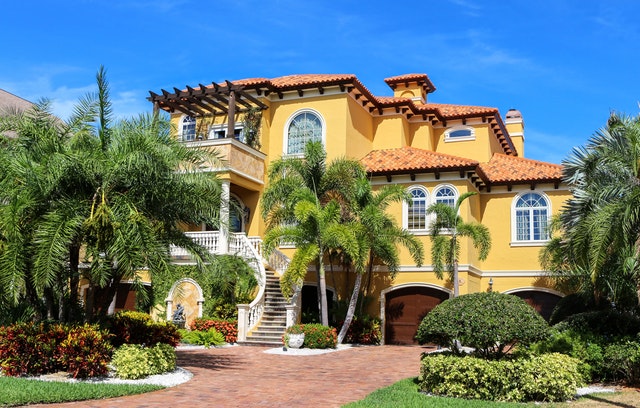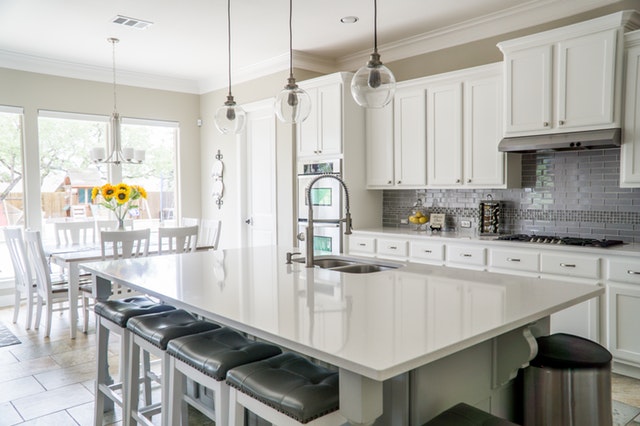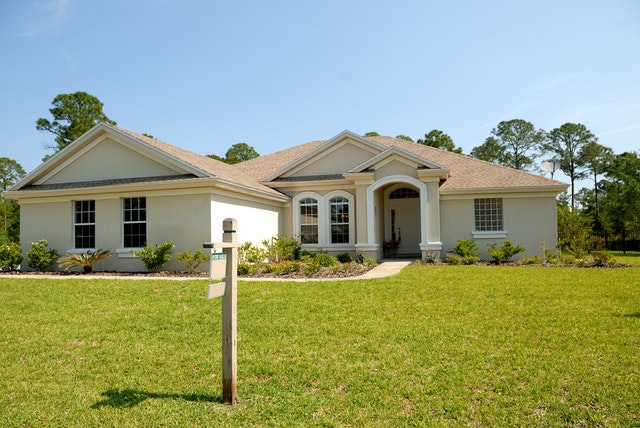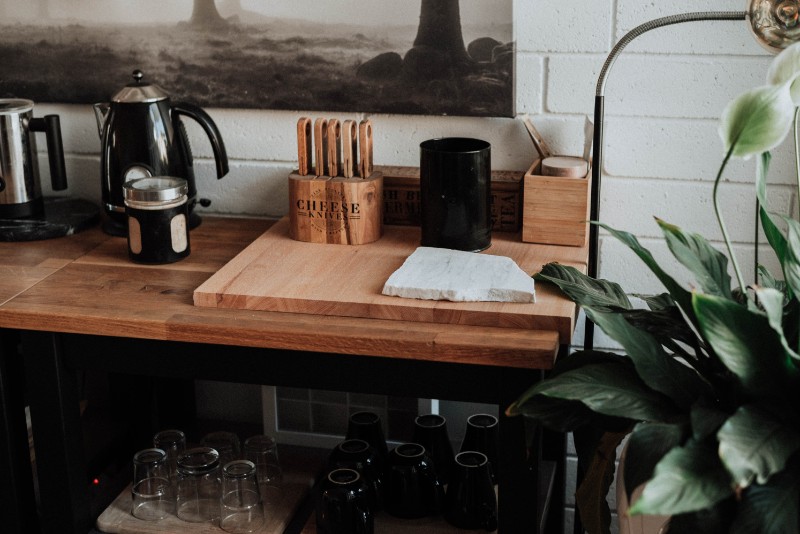Author: Igor Nastaskin
6 Easy Curb-Appeal Tricks That Will Cost You Less Than $200
Before you even think about selling your home, you have to make it sparkle—after all, prospective buyers will be peering in every corner, closet and cabinet they can get into looking for some curb appeal. That being said, it’s sometimes easy to overlook the first (and arguably, most important) space buyers will judge: the outside. So, you’ll want to make sure and present a good first impression by getting your exterior in top shape. Fortunately, this doesn’t have to cost a bundle. It’s entirely possible to add instant curb appeal using less-expensive means. Here, Realtor.com offers six ridiculously easy ways to boost your home’s curb appeal—all for $200 or less. Make your exterior sparkle with a pressure wash For potential buyers, the walk up the driveway is their first look at your home. Repaving the entire driveway would be nice, of course. But on a budget, pressure washing—which will cost between $80 to $200, on average—will do wonders. Driveways can turn green and black with dirt, and you might not even notice it because you see it every day. White driveways and sidewalks really pop. Max out your use of mulch and drought-tolerant plants It’s easy to rack up the bills with elaborate landscaping, but it doesn’t have to cost a fortune. Completely dead, neglected front yards can be converted into buyer magnets for around $200, especially if you’re able to do some of the work yourself. The secret? Put down fresh mulch in the front yard and gardens, and add easy-to-care-for plants such as ornamental grasses, bushy lavender and salvia plants—all of which are drought-tolerant and affordable, and can make a dramatic pop against dark mulch. Mulch not only brightens up the exterior of your home, it also can reduce the weeds and fill in bare spots so your lawn will look neat and tidy. Lure in buyers with fresh honeysuckle Try planting some honeysuckle along the path to the front door. This hardy plant is heat-tolerant and also thrives in the shade, and it can be used in various ways—as a bush, vine or ground cover. The sweet nectar also brings in beautiful hummingbirds, and of course, the fragrant smell also helps when potential buyers are viewing the home. Add symmetrical planters Savvy home stagers and landscapers rely heavily on visual tricks to draw buyers’ eyes to the right places. One of their biggest secrets? Symmetry. Try anchoring each side of your front door with pots filled with bright flowers such as hydrangeas. Having one plant by your door will look lopsided to potential buyers. Note: Don’t use plastic containers. Ceramic or terra-cotta pots will add a special touch and give your home that luxe factor. Freshen up the front door Adding a fresh coat of paint to your front door is an easy and inexpensive trick that can transform your home. Buyers sometimes stand at the front door for a couple of minutes while the agent is getting the key out of the lockbox, so make those moments count. You can’t go wrong with a shiny new coat in a classic color such as black, gray or red, but if you’re feeling a little daring and really want to stand out on the block, opt for a cheery pastel hue like a light green or orange-pink. Roll out the welcome mat A new welcome mat and an elegant wreath are inexpensive yet inviting ways to enhance the exterior and welcome potential buyers in for a home tour. Look for a cheery welcome mat, or if your sale is happening during a holiday, go for something seasonal.
Getting ready to move? Here are 7 Qualities of a Good Neighbor
Getting ready to move into a new home? Know that to have good neighbors, you must first be one yourself. Here, Zillow offers seven techniques that can help win the approval of your entire neighborhood. Bring cookies Delivering fresh-baked goods is an ideal way to break the ice and let neighbors know that you’re thinking of them. Avoid gratuitous gabfests If your neighbor seems to know the dirt on everyone within a two-block radius, you can count on them to keep tabs on your personal life as well. Talking with a nosy neighbor? Move the conversation along by refocusing the conversation. “So, what are you growing in your garden this year?” Share phone numbers You always should have your neighbors’ phone numbers, just in case, they receive your package by mistake, your house floods while you’re on vacation or even if you need a babysitter. Feel uncomfortable bringing it up? Ask during one of your cookie deliveries or right before a trip. Jot down your name, number and email address on a piece of paper and ask if your neighbor is comfortable sharing theirs. Be Tidy Always respect the sensitive tastes of others and clean up your act. Keep the ironic lawn ornaments to a minimum, and hide trash receptacles in the side yard or garage. Whenever you’re finished gardening or landscaping for the day, stow your tools and bags of unused mulch. Rake the leaves and clean up grass clippings. And, if it’s not too much trouble, pressure wash and paint your house periodically. Mow the lawn An unkempt and weedy lawn is embarrassing for your neighbors, so it should be embarrassing for you as well. Keep it mowed every week or two, and also be sure to trim the edge of your lawn regularly, fertilize on schedule and keep weeds to a minimum. Keep your foundation plantings simple, neatly trimmed and topped off with mulch. You also might want to go the no-lawn method and plant low-maintenance, drought-tolerant ground covers. Of utmost importance: Don’t overdo it on the sprinklers, especially when it’s raining. Communicate A good neighbor must respect boundaries, but they should also be crossed if you are unhappy with their shoddy workmanship or neglected maintenance, for example. Address shared interests such as fences, drainage ditches, and troublesome trees ahead of time so that you can work out a plan upon both parties can agree.
Today’s Kitchen Trends That Millenials Want
Thirty-five percent of millennials who own a home or are likely to purchase a home in the next few years said the kitchen is the most important room when it comes to the house hunt, according to a nationwide survey of more than 1,000 millennials conducted by meal kit delivery company HelloFresh. Forty-eight percent said they would be more encouraged to cook at home more often if they had an “updated/amazing kitchen.” But what makes a kitchen amazing? Teaming up with HelloFresh, Redfin analyzed the listing descriptions of millions of homes that have been placed on the market during the past eight years and tracked how often specific kitchen terms are mentioned. Here, some insight into what is believed to be the key selling features. When it comes to countertops, granite is a rock-solid choice, but quartz is a notable up-and-comer So far this year, 3.7 percent of all listings included a mention of granite, making it the most common keyword Redfin analyzed. Marble also is growing in popularity. In 2010, 0.4 percent of listings mentioned marble, compared with 0.7 percent of listings in 2018. While marble is mentioned more often than quartz, quartz is growing in popularity at a faster rate. Stainless steel remains the standard for appliances Stainless steel was the second most-frequently mentioned the keyword in Redfin’s analysis, appearing in 2.4 percent of all listings thus far in 2018. This stalwart trend shows no sign of falling out of favor. Buyers still love breakfast bars and islands Appearing in 1.25 percent of all listings this year so far, the breakfast bar was the third-most commonly mentioned keyword and continues to grow in use. In 2010, just 0.3 percent of listings mentioned the term. Many buyers are keen on kitchen islands. In the HelloFresh survey, 64 percent of respondents said a big island is a must-have feature in their dream kitchen. Maple cabinets are out; farmhouse sinks and tile backsplashes are in When it comes to kitchen decor choices, maple cabinets appear to be falling out of favor. Sellers instead are choosing to highlight tile backsplashes and farmhouse sinks. In 2010, only 0.1 percent of listings mentioned a tile backsplash compared to 0.8% in 2018. While listings that mention farmhouse sinks represent a tiny share of all listings, the growth rate in the use of the term has been at more than 40 percent for the past five years. Mentions of ‘tile backsplash’ have also been consistently growing since 2010. Buyers adore the entertaining extras Use of the keywords outdoor kitchen, wine fridge and double oven are rising in popularity. This includes kitchens with a dedicated beverage area, with a wine fridge below and an attractive place to display barware above, along with a double oven and outdoor kitchen area. Although these features are considered standard in luxury homes, they are becoming more popular in mid-priced homes and can really set a listing apart from others.
Offer Was Rejected? This Might Be the Real Reason Why
You’ve found a house you love and made a good offer. Unfortunately, it was rejected. What gives? Although home sellers don’t have to explain why they pass up what seems like a perfectly fine offer, they do have their reasons—and it’s not always just because a higher bidder came along. Sometimes it’s you. Here, Realtor.com tells you what not to do or say when you really want a house. Your offer letter revealed a little too much When bids are very close, things like a personal offer letter can either help or hurt, depending on what it says. There are many agents who swear by the power of a heartfelt offer letter, but make sure that you don’t in any way insult the sellers or their taste. For example, never go on and on about the huge remodel you want to do once you own the house. This can be a slap in the face to sellers who have spent a considerable amount of money remodeling the property. And, if you want to write a poem to the sellers, make sure that it doesn’t contain spelling errors throughout. A seller can be turned off by an improper use of grammar. Your offer was too high—really A higher offer isn’t always better, since lenders will only loan you as much as the house is appraised for—not a cent more. A solid, realistic offer is a much better move—or, if you do bid high, make sure you’re willing to cover the difference out of your own pocket. For example, if you a seller receive two offers over list price (one of which is $15,000 higher than the list price), the seller might be tempted to take the higher officer. However, the house might not appraise for the higher amount, which means the loan might not close. So, the seller likely will go for the lower offer. Your lender was unfamiliar to the seller A real estate agent and seller often feel more comfortable with a local lender they know. Do your research and choose the loan that’s right for you, and consider giving preference to a well-regarded local mortgage lender when possible. Sometimes, if a seller receives an offer from a buyer using an online lender they’ve never heard of, it could make them wary. You can’t be sure that an online lender will understand the local customs and laws, specifically if they might worry the septic system was a risk and deny the loan. A local lender would already understand. You demanded a family heirloom If you love the house, as well as something in it, go ahead and request to include it in the deal. However, if it’s something the sellers want to take, let it go. It’s not worth losing the entire house in your bid for a pretty light fixture. For example, if the sellers exclude all of the chandeliers in the house, they might be surprised if an offer comes in that insists on keeping the chandeliers. The chandeliers could, in fact, be family heirlooms. It’s a better idea to ask if the sellers will provide a credit for the replacement of the lighting fixtures. You made a full-price offer but nickel-and-dimed elsewhere Although sellers love to see full-price offers, don’t try to get money out of them elsewhere. For instance, never submit a full-price offer and then request a sum such as $10,000 for closing costs. That means the sellers are not getting a full-price offer, but one that’s $10,000 under the offer. You acted like you had something to hide Playing games or withholding routine information can make the seller doubt you and your intentions. For example, a buyer shouldn’t insist on remaining anonymous and ban their real estate agent from providing the sellers with any information on them at all. This could leave the sellers feeling that the whole deal could wind up being a shady experience, and they likely will pass for another more upfront offer. Your financial picture didn’t look solid enough The last thing a seller wants is to get ready to close, only to discover that the buyer cannot complete the transaction and it’s back to the drawing board. Buyers should make sure to clean up their credit and have their finances in order before making an offer. Never, for example, come in with a low down payment, a very high debt-to-income ratio, and a subpar credit rating. This will set off alarms, as the seller might question the buyers’ ability to get their loan funded and close the transaction.
6 Ways Buyers Can Stand Out, Beat the Competition and Buy the House
In a seller’s market, there can be many home buyers and too few houses. If you’re a buyer facing this dilemma, that means you need to figure out how to beat the competition and buy the house. Typically, when faced with many bidders, sellers will pick the highest offer, an all-cash offer or what gets them to the closing table the quickest. But if you can’t plunk down a lot of cash or waive a home inspection, there might be other ways to stand out, especially if you’re flexible on certain points or have specialized skills. Here, Realtor.com shares some creative—and kind of crazy—ways people have sweetened their offers. 1. Toss in free pizza for life! When Rob and Holly Marsh put their Oregon home on the market in 2015, they had multiple offers within days. One buyer had even offered $26,000 over the asking price but had a feeling that wasn’t quite enough to nail the deal. So, she threw in one pizza a month for life. The Marshes accepted the offer. How could they resist? Besides, when you add it all up, that much pizza was worth serious dollars—a free $20 pie once a month for the next 40 years amounts to $10,000 total. And it makes a business deal a more personal bond. 2. Fix what’s wrong with the house Here’s how Terence Michael snagged a beach house in Playa del Rey, Calif., in 2005’s hot housing market: He noticed it came with a detached garage that had been converted into a rental unit. Problem was, it wasn’t up to code—so most buyers were leery. Enter Michael, who had completed some of his own home renovations in the past and knew exactly how to bring this otherwise perfect place up to snuff. He asked the sellers for permission to begin converting that space back to a garage, not knowing if the sellers would accept his offer. Since the owners had little to lose and lots to gain, they allowed Michael to move forward with his plans, which entailed installing a garage door, removing the bathroom and making other changes to get the space car-ready. After 10 days, the sellers informed Michael that the house was his—new garage and all. He wound up getting the house for $592,000 and then sold it in 2014 for $939,000. 3. Add an open-ended escalation clause Adding an escalation clause to an offer means the buyer commits to paying a specified amount more than the highest offer submitted, up to a cutoff price. On a house listed for $450,000, for example, buyers might top any offer by $2,000, up to $480,000. Taking that idea to a new level, consider submitting an offer to pay $5,000 more than the highest offer, with no cap on the total purchase price. 4. Waive attorney review The attorney review is part of the home-buying process when buyers do their due diligence and have the house inspected for any problems before closing the deal. The risk of waiving the attorney review is substantial. It could be a good idea to forego the attorney review, however, if you really want to secure your dream house with the right room sizes in the perfect location. With the attorney review waived, the sellers basically only need to set a closing date, which can be very compelling. 5. Stop by during primetime If you really want to do something to stand out as a buyer, stop by the house, knock on the door and introduce yourself to the sellers. Although contacting the sellers directly often is considered pushy, it could actually work. Nothing beats a little face time. 6. Offer a trip…or tickets to a sporting event What would you choose: Season tickets for your favorite NFL team or a trip to Paris? In Denver’s competitive market this past spring, these two perks were offered up by buyers. It may seem extreme, but it actually makes sense to leverage what you have that others might find valuable.
Thinking of Selling Your House? [5 Proven Ways to Increase Home Value]
If you’re thinking of selling your house, there are factors that increase your home value that are out of your control, including its location and the popularity of that market. But you can keep up with repairs and make smart improvements, both proven ways to increase home value. Although renovations rarely recoup 100% of their cost, they can make your family more comfortable and help your home sell faster. USA Today offers five tips to raise the value of your home, whether you want to build equity faster or get top dollar when you sell. 1. Make it more attractive Curb appeal—how your home looks from the street—is your first chance to make a good impression. A home’s exterior should entice a prospective buyer to walk through the front door. Make sure existing landscaping is well-maintained. If your yard seems dull in comparison with your neighbors, consider planting flowers or repainting the front door. Once the exterior looks good, focus on the kitchen and bathroom. When these two rooms are outdated, they can keep a property from reaching its highest valuation. A minor kitchen remodel recoups 81 percent of its cost in added value on average, versus 53 percent for an upscale kitchen remodel with stone countertops, custom cabinets, and commercial-grade appliances, according to Remodeling magazine’s “2018 Cost vs. Value Report.” The same is true for bathrooms; a midrange remodel with new flooring and a few updated fixtures deliver a 70 percent return on investment, while an upscale bathroom remodels with heated flooring, custom cabinets and designer fixtures nets an average of 56 percent. 2. Make it low-maintenance Since many homebuyers worry about purchasing a home that will need constant maintenance, replacing a major component—such as the furnace, water heater or even the roof—before placing it on the market may calm fears of an emergency repair in the near future and help you get a higher price. Improvements that make things easy to clean and maintain also may increase home value. Consider replacing easily stained carpet with hardwood flooring or high-maintenance wood siding with vinyl siding. 3. Make it more efficient Depending on what area of the country you’re in, energy conservation features can have a significant impact on home value. Energy-efficient mortgages (EEMs) allow borrowers to take on additional debt to cover both the purchase of the home, as well as energy-efficient upgrades. EEMs also can offer lower mortgage rates to increase purchasing power. Consider double-paned windows, enhanced attic insulation, LED lighting, efficient appliances and solar panels. Schedule an assessment with a certified energy auditor or your utility company to determine where your home is wasting energy and which upgrades will save you the most money. 4. Make it bigger Price per square foot is one way to compare homes that are similar in style and upgrades. Bigger homes often command higher values, and even if an appraiser doesn’t officially acknowledge the full value of added space, a buyer likely will notice. Adding a room is the obvious way to make your house bigger, but you also can create additional living space by finishing the basement or building a deck. 5. Make it smarter Most buyers are seeking “smart” technology in their new homes, including thermostats, fire detectors, carbon monoxide detectors, security cameras, door locks and lighting. While smart technology doesn’t always increase home value, it does add appeal, with those who see themselves as “techies” more likely to pay more for these items. Unlike replacing the roof or renovating the bathroom, you usually can install these devices yourself for about $1,000 or less.
7 Vintage Kitchen Design Trends That Are Making a Comeback
Thinking of selling your home? You might want to try incorporating well-placed throwbacks from decades such as the 1930s into your kitchen’s cooking and dining spaces, as well as rethinking your culinary center’s size and color palette. According to Realtor.com, these are the types of vintage style trends that today’s homebuyers are seeking. Pastel hues Today’s younger generation is pairing the popular rosy shade with gentle hues like robin’s-egg blue and mint. To make these shades sing, choose a modern countertop, such as a butcher block, but consider skipping dated wood cabinetry. Petite kitchens For millennials to afford housing, smaller kitchens are becoming more popular. Instead of having eating, cooking and entertaining in one large room, consider seeking out separate—and, subsequently, smaller—spaces. To make your limited square footage feel grand, look beyond white walls: bold colors and bright metals add vintage glamour and turn the cozy space comfortable. Retro furniture design A smaller kitchen lends itself nicely to retro furniture. Vintage designs—such as Eero Saarinen’s tulip chairs—are designed to squeeze into tight spaces without looking bulky or oversized. Remember, though, it’s easy to go overboard with retro looks. Balance these styles with modern elements—such as stainless-steel appliances or waterfall islands—to keep your home stylish. Dining nooks An open kitchen layout is the perfect place to rock the latest retro trend: dining nooks. Built-in benches add character while also providing an easier alternative to cluttering an open space with a lot of chairs. Decorative flooring Hardwood flooring (laminate or otherwise) might be standard issue in builder-grade housing, but many buyers are seeking decorative flooring styles often seen in their parent’s and grandparent’s homes. Whether it’s vintage black-and-white or funky-patterned tiling, today’s kitchens are all about making a statement. Not quite ready to go so bold? Add a subtle nod to retro chic by upgrading to white and light-gray checkerboard tiling makes. Vintage appliances Retro refrigerator maker Smeg had its moment in the kitchen spotlight with its candy-colored appliances, and now other manufacturers are following suit with a variety of vintage-inspired appliances. Not only are they ideally suited for Mid-century Modern–style homes, they work equally well in a beach cottage or cabin—or any kitchen setting in need of a sense of fun and personality. You don’t have to go pastel to integrate vintage appliances into your own kitchen. Many manufacturers, like Northstar, offer retro lines in white, and Elmira makes the look modern with stainless steel. Bold pops of color Pastels aren’t the only option when adding vintage color. Bold shades are perfectly retro—and makers of small appliances offer unlimited options. Pick a vivid, colorful coffee maker or a mixer that is modern, while still having a vintage look. Or choose eclectic accessories and artwork to bring cheer and drama to your space. Just don’t go overboard: You want your kitchen to be bold, not loud. Limit the use of bright colors to appliances and a few accent pieces to make the design easier to live with for an extended period.







